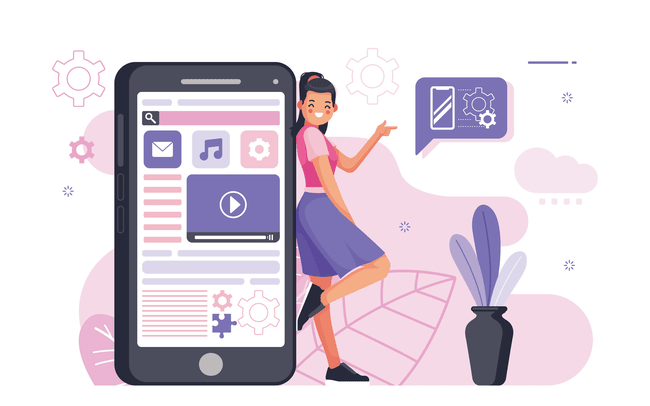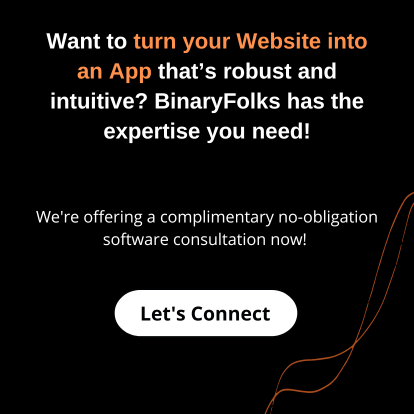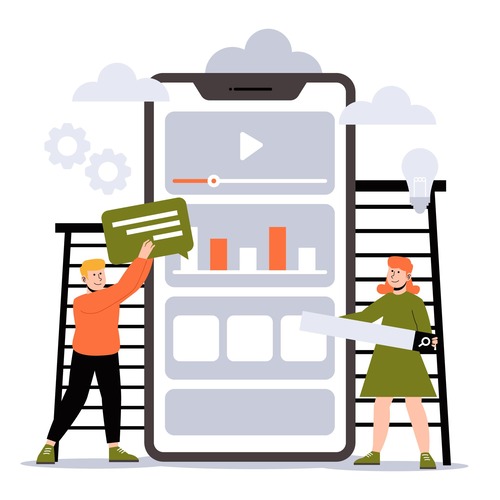If you've been looking for a resource to understand how to “actually” turn your website into an app, then you’re at the right place! In this blog, we will be discussing everything you need to know before you can create a genuine application from your website, no gimmicks, no template-based website shortcuts.
According to a study, mobile devices contribute to around 58.67% of the global online traffic. Combining this statistic with the fact that apps make it easier for the audience to access and engage with the offerings of the website, has driven businesses across industries to turn their websites into apps.
However, the moment an entrepreneur starts their research around “how to convert their website into a mobile application”, they’re instantly flooded with a number of sites offering to set up their application within minutes, and that too for free! Initially, it might seem like a really great offer, however, once you dig deeper into these services – you quickly realize why they are free.
Your Authentic Mobile App Awaits!
The Truth Behind the “Free Services” Converting Websites into Apps
In most cases, these so-called apps simply represent a cased-up version of a website with the exact same look and feel that you would experience if you accessed the website using a mobile’s default browser.
Another alternative method some vendors use is to templatize your website and mold it into a generic app with the most basic features. After asking you a series of questions regarding your website, the free application service providers fill the gathered information into a cookie-cutter mold. This is the same template they will be using for other websites that might belong to the same industry as yours, or a completely different one.
Overall, if you choose to go ahead with these methods for the development of your website's application, then you will be missing out on receiving an application that is built by an experienced software development team with your business goals as the main focus, it won’t be providing your users with an enhanced experience either. Also, it is very likely that this kinda application will fail to pass the quality checks of some of the popular app marketplaces, meaning there’s a good chance that you might not be able to list your app on platforms like Google Play and App Store.
What is The Proper Way to Convert a Website Into An App?
If you’re serious about developing a proper application that enhances your audience’s user experience significantly, then investing in a custom native application will be your best option. An application that is built from scratch with your website at its center, allows the developers to understand your business’s primary objectives and create the entire layout accordingly. Now at this point, you might be wondering – “How much is developing a native application gonna cost my business?”. A very valid question, although the exact cost can largely vary depending on the specific requirements.
But before we get into the factors that impact the cost of developing an application, there’s another really important question that you need to ask! And that is – Can my website be converted into an application in the first place? The answer –
Theoretically, yes, any website can be converted into an application, but whether the cost of investing in an application is practical for your business specifically is a question that needs some analysis as there are a few scenarios where opting for an application does not have a justifiable ROI –

[a] Website Complexity
If your website is on the simpler side and does not have a roster of fancy features, for example – a website that is focused on releasing blogs from time to time, then you might be better off without an application. A well-optimized website should be sufficient to provide your audience with a seamless experience without any additional expenses.

[b] Cost to Return Ratio
The intent behind developing the website and the scale of your business also need to be accounted for. Basically, if you are an early-stage business and have analyzed that developing an application will directly help you to scale, then you should definitely invest in it.
How Subscribing to the Native Application Idea Benefits Your Business
With all points considered, if you choose to go ahead with the decision of converting your website into an application, then you are definitely setting your audience up for an elevated experience. Including benefits such as –

[i] Enhanced User Experience
Websites are designed for larger screens, and using the same layout on a much smaller screen can be difficult. With a mobile application that is designed while keeping small screens across different resolutions and ratios in mind, you can ensure that the users can explore your services through any device, seamlessly. You’re not bound to include all of your website’s deliverables on your app as well, which allows you to focus the intent of the application on a specific service (if you want to).
The users can also leverage a much-improved experience with smoother animations, faster loading times, multi-touch functionalities, and a mobile-centric layout. In its absence, users have to struggle with un-optimized mobile screens, leading to extremely small fonts, and complicated & overwhelming designs that take a major toll on the user experience.

[ii] Notifications
There are two core ways applications can leverage notifications, first, reminding the users about a scheduled event that they consented to previously. And second, to market yourself with the help of offers and content that creates a “pull”.
It is arguably one of the most versatile features of an application as it allows your organization to be on top of the user’s mind. But you need to make a few considerations. An average user receives up to 80 notifications per day which can go as high as 200 notifications depending on the occasion and the number of applications installed in the user’s device. This clearly means that sometimes it can be overwhelming for the users to receive so many notifications, pushing them to manually disable notifications for certain applications or for the device completely.

[iii] Offline Access
While the majority of us readers have a seamless internet connection, there are many parts of the world where the internet is still a luxury. Offline access to some of the application functionalities allows users to seamlessly access the applications in remote locations where internet connections are either patchy or completely absent.
A popular use case of this feature is – during surveys or any other information-gathering campaigns for a government relief policy in remote areas of the world. Even without any access to the internet, the representative can visit the remote locations, acquire the information, and fill it up in a form within the application while being completely offline, and all of this data is locally stored on the device. When the user returns to a location with stable connectivity, all of the collected data is uploaded to a central cloud-based server. But this is just one example, be it downloading music offline to listen to while traveling or keeping an offline version of the map when visiting places, the use cases of offline access to applications are plenty.

[iv] Accessibility
An installed app is always easier to access compared to opening your website in a browser. Those extra steps can make a big difference in user engagement. Although there is an initial challenge of convincing the users to install your application in the first place, once that barrier is crossed, there are several new strategies you can try out.
Furthermore, if your business wants to leverage some of the native features of a mobile application that you were unable to implement with a website previously, that can be easily included as well. For example: Let’s say you have an ecommerce website and with a new mobile app you want to add an Augmented Reality feature, something that wasn’t possible previously.

[v] Brand Recognition & More Visibility
With a native application, your brand has the opportunity to be placed on the user’s home screen, which means every time a user unlocks their device, your application will be right in front of their eyes. This is a significantly better option to be on top of someone’s mind compared to your website being stored in a browser’s bookmark section.
What To Consider Before Developing an App with a Software Development Partner
Developing an application demands a significant commitment of business resources, and as an entrepreneur, it is important for you to analyze some of the key factors to ensure that the venture is indeed a success –

[A] Genuine Need
Conduct a survey if you have a user base already or a market analysis if you are starting off fresh to understand the market’s need for an application. Try identifying the features on your website that you can improve on an application, and parallelly devise your monetization strategy. You can also take the research a step further and analyze how your direct competitors are operating – Do they have an application of their own? What features are they selling their business around? How can you improve on those features and services to capture their user’s attention? – Finding an answer to these questions can give you a strong idea of the need for an application for your business.

[B] Development Cost
Consider factors such as the design specifications, the tech stack to be used, cross-platform support, and other factors to come up with an approximate amount you will be spending on the project. Next, calculate this cost of development against the long-term revenue boost the application will provide your business. If the profits make sense then you are on the right track. Be wary of the hidden costs as well (if relevant to your case), such as – app store fees, marketing budgets, APIs & any other third-party integration costs.

[C] Restructuring
Here’s the thing, some websites are easier to convert into applications than others. For example – while content-driven websites like blogs and new websites are fairly straightforward and easy to transform, some highly interactive websites with advanced JavaScript features or some websites with real-time data processing can be difficult to translate given the limitations of an application. The latter option naturally has a higher cost of development as some of the core features might need to be built from scratch.
How to Turn a Website into an App
While the complexity of converting a website into an app may vary from business to business, the core procedure remains the same throughout. Let’s discuss the step-by-step process that ensures the application being developed is in sync with the business goals and is built within a reasonable time and budget –

[1] Chalk Down the Requirements
First up, gather the stakeholders and the developers for a meeting, finalize the project requirements, and make a complete BRD that describes the project specifications in depth. It should include a detailed list of the features, the architectural approach, and all the external and internal integrations. The development period should be broken down into phase-oriented milestones so that as a client, you can track the progress of the development of the project with more transparency. Once both parties agree and sign on the specifications mentioned, the project can officially begin.

[2] Finalizing the Design of the App
This phase typically consists of wireframing, making the application mockups, and other UI/UX focussed elements of the application. The development firm should make sure they match the branding, font, and other details of the original website. The backend architecture also needs to be planned simultaneously. If the application is designed using an API-first or microservices-based approach, then these steps should be finished before the development of the actual application modules begins.

[3] Developing the Application
Next up is the development of the actual backbone of the application, this phase is typically divided into multiple milestones as it may take weeks or months, depending on the complexity of the application. In case the websites are hosted on WordPress or Shopify-like services, they get the benefit of leveraging APIs that support this website-to-application transition, making the development phase relatively shorter. On the other hand, the development of apps where there’s a need to develop certain modules from scratch takes significantly longer.

[4] Testing for Any Bugs
With the main mold of the application ready, it’s time to let the QA’s do their sculpting. After multiple cycles of rigorous testing and after addressing all of the possible test cases, the application can be finally considered – “market ready”. This application is now tested across various devices and across platforms (if applicable), to test across multiple parameters, the user experience is also evaluated by the internal team. Once all the boxes are checked it is time to finally let the application go out to the intended audience.

[5] Alpha and Beta Phases (Optional)
The alpha testing phase is another expanded form of the internal testing phase. Previously, the application was tested only by the quality analysts and the development team. But in the alpha phase, the application is handed over to the other members of the organization who were not involved with the development, the members from the client’s side also participate in this phase. Once it is approved by the internal lot, the application is pushed to the beta phase.
This is where the application is launched to a small group of end users, where they have the opportunity to be the first individuals to try out the application and raise any bugs and issues that they may come across. The problems detected (if any) are promptly resolved by the development team until no issues remain.

[6] Launch Of the Application
Once the application is approved by the beta users, it is finally time to let the application out to the masses. Depending on the business requirements, the application will either be uploaded to the Google PlayStore or the App Store, and the users can download it from those platforms. Or the .apk file could be distributed to the intended users individually if the application is supposed to be exclusive to a certain group of people.

[7] Maintenance
The thing about mobile apps or software in general is that they cannot remain “cutting-edge” for a very long time. As new features and technologies launch every other day, after a certain point they do need to be reworked and reinvested into in order to stay on par with the industry standards. This is where we join the team once again to help your business stay on top of your game and your competitors once again.
A Team That Can Turn Your Website Into a REAL App!
Since you are at this point, you might be closing in on the decision on whether to turn your website into an application or not! Well, with all points considered, if you did choose to go ahead with the enhancement of your website into an application, we gotta say you made the right choice! Developing an application is highly beneficial if you can get your users hooked. The ease of access and enhanced user experience will elevate your brand value in front of the world.
Now with the decision made, all you need is a partner to get you started! Someone who understands the intricacies as clearly as you do now and holds the experience of developing premium quality software. And who can be a better pick for this position if not the team that clarified these concepts for you in the first place? 😉
Contact Our App Development Experts!






